Art World
Joan Mitchell Is Having More Than a Moment. Here’s How the Artist’s Foundation Has Championed Her Market and Legacy
The artist's market has skyrocketed, but the Joan Mitchell Foundation's work to secure her legacy is constant.
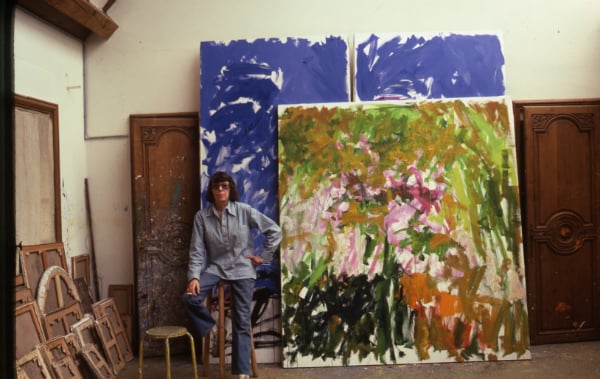
The artist's market has skyrocketed, but the Joan Mitchell Foundation's work to secure her legacy is constant.

Sarah Cascone

 When it comes to an artist like Joan Mitchell (1925–1992), one could argue that she has been, in recent months, the beneficiary of an overdue art historical reckoning. The postwar painter, known for her important place in the storied Abstract Expressionist school, has seen an explosion in her market.
When it comes to an artist like Joan Mitchell (1925–1992), one could argue that she has been, in recent months, the beneficiary of an overdue art historical reckoning. The postwar painter, known for her important place in the storied Abstract Expressionist school, has seen an explosion in her market.
The 1969 canvas Blueberry set a new auction record for Mitchell in May, selling for $16.625 million on a high estimate of just $7 million at Christie’s New York. In June, Mitchell was the talk of Art Basel in Basel, with $70 million worth of her paintings among the fair’s hottest commodities. According to sales reports, three works sold collectively for somewhere in the region of $35.5 million.
While the fair was still in full swing, the Baltimore Museum of Art and the San Francisco Museum of Modern Art announced plans to stage a massive Mitchell retrospective in 2020, the artist’s first in the US in nearly two decades. Despite the timing, this wasn’t a last-minute attempt to capitalize on the artist’s hot streak. Curators Katy Siegel of the BMA and Sarah Roberts of SFMOMA have been working on the exhibition since 2015.
And it’s not as if Mitchell, suddenly a market force, has come out of nowhere. The Joan Mitchell Foundation, which turns 25 this year, has been quietly working behind the scenes to promote the artist’s legacy all along. The foundation’s efforts to encourage scholarship, to exhibit Michell’s work, and to compile a comprehensive catalogue raisonné, have gone a long way toward securing greater recognition of her art historical significance.
Christa Blatchford, the foundation’s CEO, spoke to artnet News about Mitchell’s growing moment, how the foundation’s work has helped to bring the late artist the recognition she deserves, and how it continues to work to fulfill her commitment to supporting other artists.

Joan Mitchell Foundation CEO Christa Blatchford. Photo by Jeremy Tauriac, courtesy Joan Mitchell Foundation.
The art market is seeing pretty gigantic shifts in how mid-century work by women artists is valued. What does that mean for a foundation in control of an artist like Joan Mitchell’s legacy, and what does this shift mean for the foundation going forward?
Part of our mission and inherent in our DNA is to continue to cultivate scholarship and thought around Mitchell. Those methods continue to evolve as recognition and dialogue and discourse around Mitchell increases, which is very exciting to us.
The spectrum of things for us to do actually grows in exciting ways—as the public awareness of Mitchell increases, there are more people thinking about doing dissertations about Mitchell and her peers. More scholars want to come into our archives, which is fabulous. We want to make those resources available.
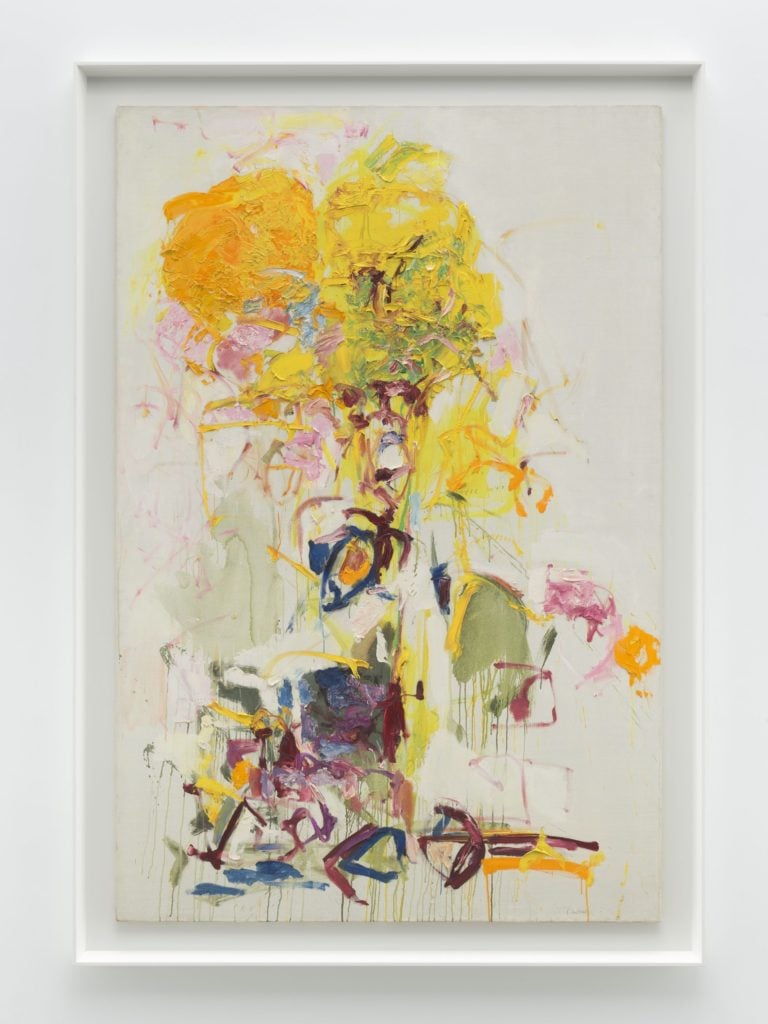
Joan Mitchell’s Composition (1969), which sold for $14 million at Art Basel in Basel in 2018. Courtesy of Hauser & Wirth.
How do you go about encouraging scholarship that can bring greater recognition for Mitchell’s career?
We hired a research conservator recently who is doing a lot of work in really understanding the materials of the paintings and studying the process more deeply. We see that as part of our obligation, but also an opportunity for the field to learn about Mitchell. We’re regularly inviting people in to study at the foundation. This gives them access to the information they are excited about, but it is also important that their findings are shared more broadly.
When Katy [Siegel] and Sarah [Roberts] came to us years ago about organizing a [BMA and SFMOMA] retrospective and mentioned including Mitchell’s works on paper, that was very exciting. We have known for a while Mitchell’s works on paper are really under-recognized. For us, it was a priority that people not think of her as simply just a painter. We set those types of goals internally, and then we seek opportunities of ensuring that that information gets out there. This retrospective was planned well in advance of all the market hype. What’s exciting is that there hasn’t been a substantial look at both Mitchell’s paintings and the works on paper, so they’re looking at her holistically in a way that has never been done before.
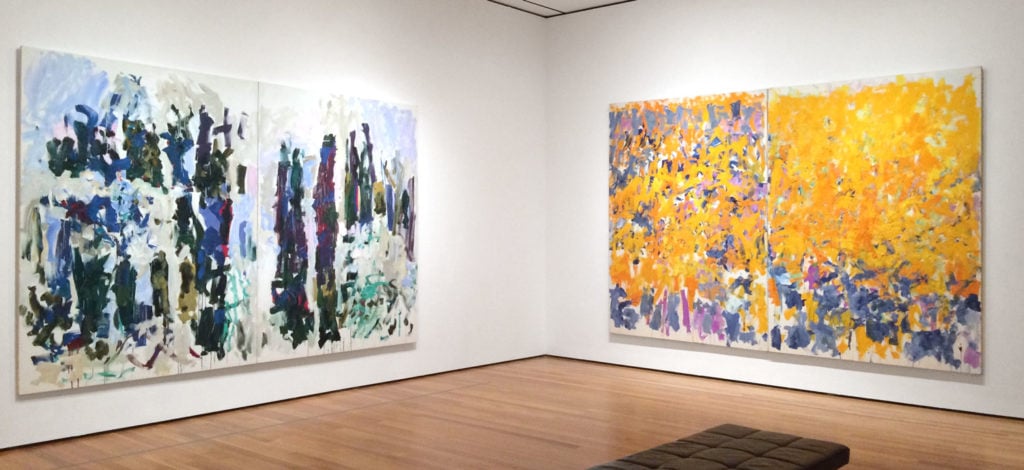
Left: Joan Mitchell, Taillade (1990). Right: Joan Mitchell, Wood, Wind, No Tuba (1980). Photo courtesy of the Museum of Modern Art, ©estate of Joan Mitchell.
Why do you think we have seen such an increase in her price point?
There are lots of different factors. For me, the primary factor is that her work is consistently and solidly good and strong. Mitchell was deeply committed to abstraction and really pushed herself.
There is real recognition of this in “The Long Run” at MoMA [on view through November 4], which is focusing on later in her career, the 1970s, ’80s, and ’90s, and not the Ab-Ex work that she’s put in a school with. What we keep hearing from people upon seeing those pieces is “oh my gosh!” Her work was stellar throughout her career, and Mitchell was well-recognized within her lifetime. I think the market’s just catching up with that.
Some of it is also that the market has run its course on certain artists and is looking for [something] new, as it always does. Right now in art history, people are looking at alternative narratives, at artists who they see as potentially having been affected by gender or race, those types of things. There have been some who wonder, “is it #metoo?” It’s more complex than that, but there’s a reexploration of historical narratives that are important to our history and our culture that is happening right now, and that’s coming together with recognition of the quality of Mitchell’s work.
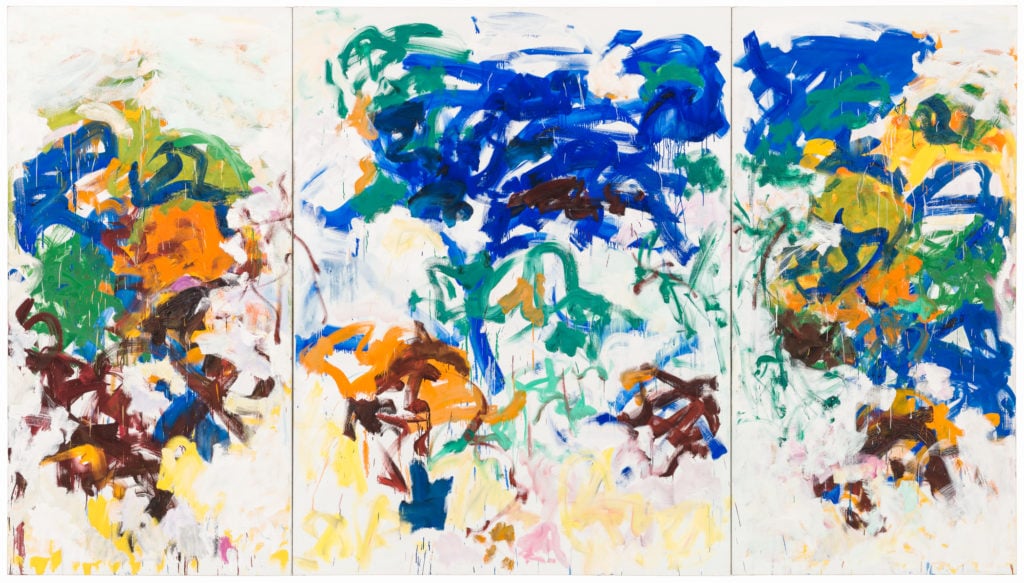
Joan MItchell, Bracket (1989). Courtesy of the San Francisco Museum of Modern Art. © Estate of Joan Mitchell.
How does the foundation manage requests for loans of Mitchell’s work and have requests increased in recent years?
Yes, we have seen in the last few years a growing momentum. We get regular requests for loans, and what’s interesting to see is the different parts of the world that are now expressing interest in her. There was a show earlier this year in Canada that was Mitchell and Jean-Paul Riopelle, and there was a show of Mitchell’s in Austria and Germany in 2015.
Every once in a while we get approached by people who are like, “I have a show in two months,” and unfortunately we can’t move that quickly. We have to get approval from the board—there’s a slightly different structure as a foundation than a person who owns a collection.
But it is very much a part of our mission to cultivate and ensure shows of Mitchell’s work are successful. Our archives and research team does a huge amount of work whenever there’s a publication, in terms of fact-checking and support. And we manage Mitchell’s rights and reproductions ourselves.
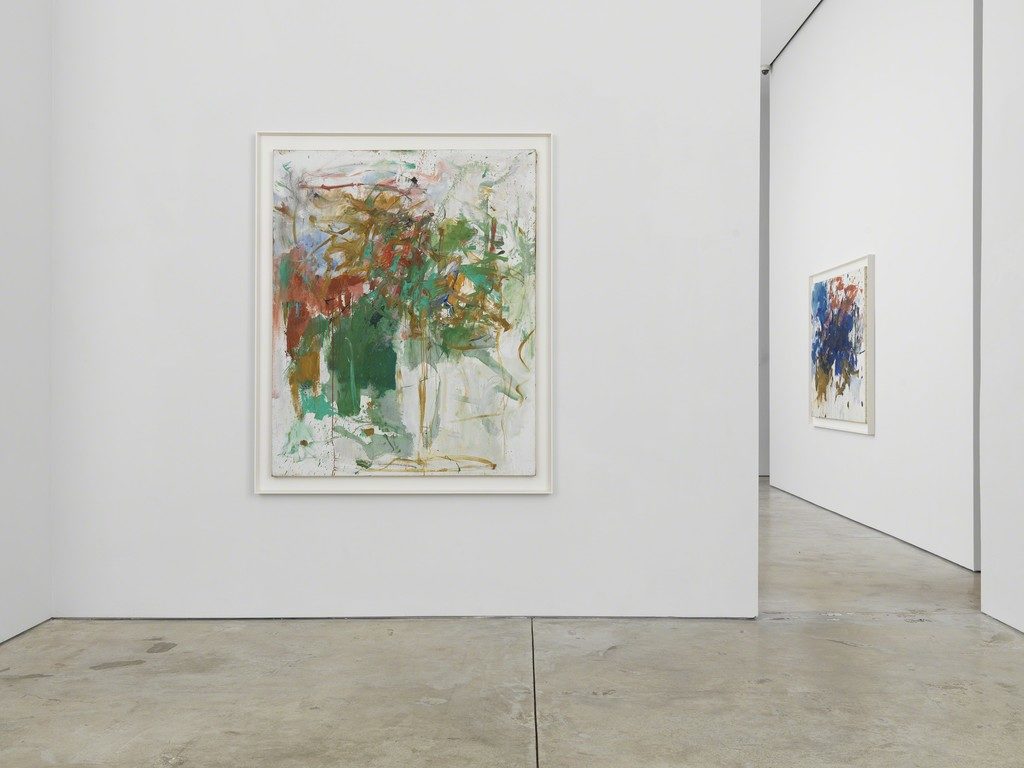
“Joan Mitchell: Paintings from the Middle of the Last Century, 1953–1962” installation view at Cheim & Read. Photo courtesy of Cheim & Read.
How important is the catalogue raisonné project to the foundation’s work and when do you expect to complete it?
The catalogue raisonné project is definitely starting some dialogue and recognition. I think realistically there’s eight to 10 more years on it, in part because of record keeping and frankly the length of time we waited after her death before starting. There aren’t the same people who can easily give you records as there once were.
But we are committed to doing it, and it’s actually really just exciting in terms of the work that we’re piecing together and discovering.
In May, the estate announced plans to cease working with longtime representative Cheim & Read, signing with David Zwirner. How did that decision factor into the foundation’s plans?
I actually don’t want to talk further about it. There’s been so much speculation about it. Cheim & Read was wonderful and great to work with, and we have deep appreciation for them. I think the show they have up right now [“Joan Mitchell: Paintings from the Middle of the Last Century, 1953–1962,” through November 3] is phenomenal. I am excited about what Zwirner is doing, but I don’t want to comment about the process of this.
And when will Zwirner have its first Mitchell show?
In April or May in 2019. I will leave it to them to announce that. We’re working on it right now!

Joan Mitchell in her studio in Vétheuil, 1983 Photo by Robert Freson, the Joan Mitchell Foundation Archives, ©Joan Mitchell Foundation.
In addition to promoting Mitchell’s legacy, the foundation is also extremely committed to providing support for artists. What sets that work apart from similar initiatives from other artist foundations?
Mitchell in her will was very specific about providing direct support to artists, which was actually a real gift to us as an organization. We’re an organization that is from an artist, for artists. A lot of our focus as an organization is based on Mitchell’s commitment to artists and their practice and their process.
Every year, we give unrestricted $25,000 grants that are nomination based and determined by an outside jury. At this point, we have given grants to over 1,000 artists nationally. It’s “we believe in you” money. And then with our artist residency program in New Orleans, it’s really about giving artists time, space, and the opportunity to connect with their process.
For Mitchell, [art] was sort of like breathing. And we hear so many stories about her support and generosity to artists in her lifetime, ensuring they had time to focus on their work and really do their practice. Our work is about how do we support artists directly, at all different phases in their careers and life? We’re always considering what it means to be a practicing visual artist, and what that support looks like.
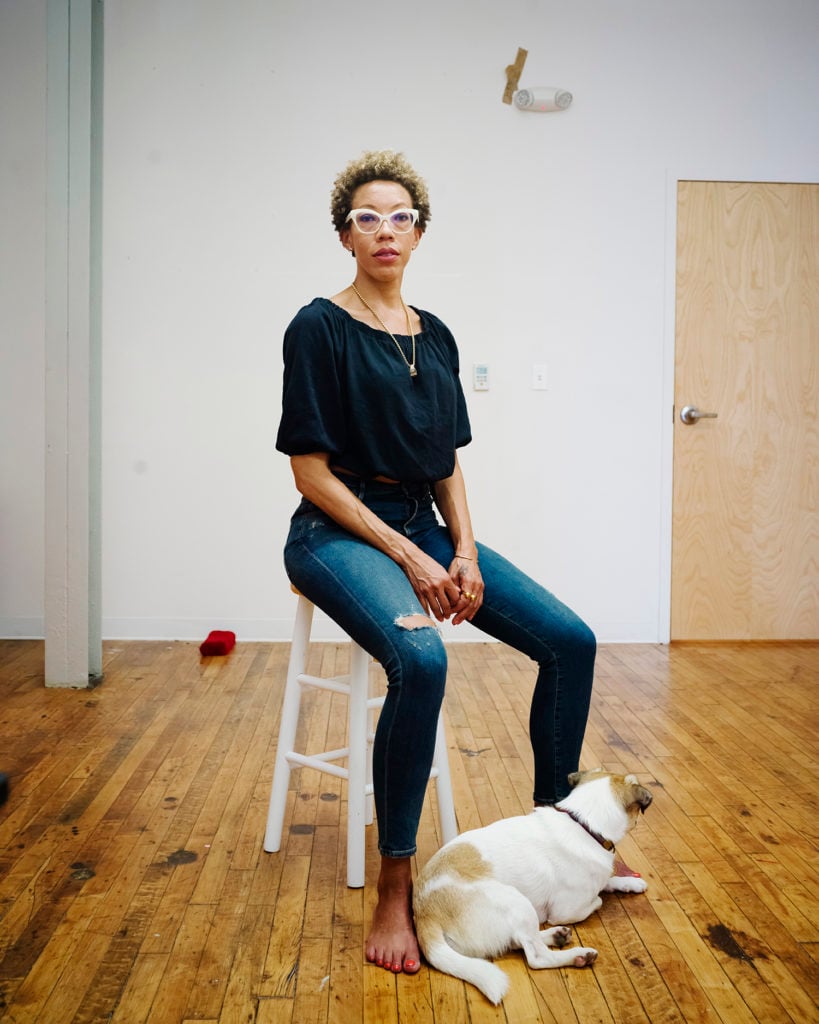
Reginald Eldridge Jr, Amy Sherald. Photo by Reginald Eldridge Jr.
That support also includes an exhibition space, right?
We recently consolidated two offices into one, and in the central part of that new space, we now have an exhibition space to showcase the work of our grant recipients. We’ve done a range of different things, and we’re still experimenting with it, but we are organizing a show celebrating our 25th anniversary as a foundation. Our network of artists is really phenomenal and it feels like an opportunity to highlight that.
We hired a phenomenal photographer, Reginald Eldridge Jr., to travel around the country and meet with some of our recipients, ranging from Amy Sherald to Mel Chin to artists who are not as well recognized He took these beautiful portraits and spoke with them [about their experiences]. We have beautiful stories of what it has meant to them to get a grant from Joan Mitchell or support from the foundation. The exhibition opens December 6.
Any chance we’ll also see any work by Mitchell in an upcoming show at the foundation?
Our office is really a working office. Having a whole bunch of Mitchells up on the walls would be a liability in terms of the safety—and I would have nightmares about people backing their chair into the paintings or something like that!
This interview has been edited and condensed for clarity.